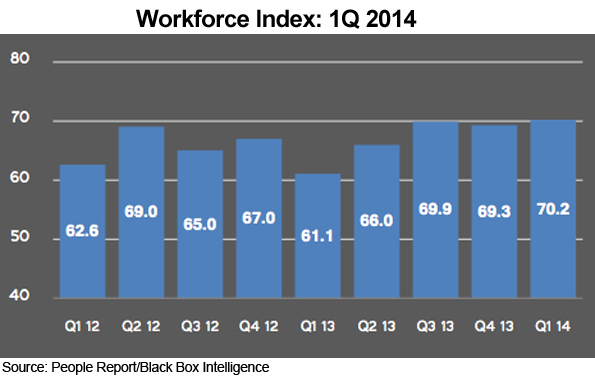The People Report Workforce Index, which measures expected market pressures on restaurant employment, nudged up in the first quarter.
The first-quarter overall index rose slightly, from 69.3 in the fourth quarter to 70.2, the highest index reading since the fourth quarter of 2006, before the start of the recession.
The reading indicated that restaurant operators will continue to face recruitment and retention challenges for the next three months, said Michael Harms, executive director of operations for People Report and sister company Black Box Intelligence, in an interview Tuesday.
RELATED
• Employment pressures remain for restaurants in 4Q
• Restaurant employment pressure nears pre-recession levels in 3Q
• More restaurant H.R. & Training news
The Workforce Index is produced by Dallas-based People Report and is based on surveys of human resources departments and recruiters in the restaurant industry. It measures from a baseline value of 50, with any results over that level indicating increased pressures on five components: employment levels, recruiting difficulty, vacancies, employment expectations and turnover. Results are based on expectations for the quarter underway.
“When you look at the macroeconomic environment,” Harms said, “we have a recipe for recruiting difficulty, from dropping unemployment to increasing turnover to companies looking to hire more employees. All that is causing employment pressures to increase.”
The Workforce Index “employment levels” component registered a value above 70 for the third consecutive quarter, rising in the quarter to 74.6 from 71.4.

The U.S. unemployment rate dropped to a five-year low of 6.7 percent in December, and the Workforce Index saw year-over-year turnover rates for all segments rise. Turnover showed a marked increase from the fourth quarter as well, rising to 65.0 from 47.0.
“That number is calculated by looking at the percentage of companies that are seeing an increase in turnover rates,” Harms explained. Companies that had seen static or slight increases earlier in the year saw turnover ramp up in the last three months of the year. “What’s clear is that turnover is on the rise,” he said.
The U.S. added 515,000 jobs in the fourth quarter, for a total of 2.2 million in 2013 —right on par with job growth in 2012. Of those added jobs, 48,100 were in foodservice — a decline from 58,000 jobs added in the third quarter and compared with 67,900 jobs added in the fourth quarter of 2012.
“Despite this dip, the industry added a total of 306,100 jobs in 2013, up slightly from 305,200 in 2012, as one out of every seven new jobs could be attributed to the industry,” the Workforce Index reported.
About 57 percent of companies reporting to People Report added staff at the hourly level in fourth quarter, and only 6 percent reduced staff. At the management level, 51 percent of companies added staff and 6 percent made reductions, the Index found.
“We’ve seen some healthy growth in the industry over the past several years,” Harms said. “It’s been steadily improving, but it’s not yet where we want it to be. The trend is in the right direction for the most part. We see companies seeking to add jobs as the industry grows.”
Workforce Index overall rankings by industry category for the first quarter compared to the fourth were mixed:
• Quick service dipped to 65.6 from 67.3;
• Limited service/fast casual/family dining increased to 74.4 from to 62.2;
• Casual dining fell to 63.9 from 69.4; and
• Fine dining/high volume rose to 75.4 from 73.4.
Recruiting might become increasingly challenging, Harms said.
“Some of that low-hanging fruit is already gone,” he said. “The labor market is not flooded with as many people looking for work as there were a few years ago. Companies must be aware that the environment is becoming increasingly difficult to hire. That may continue for some time.”
Contact Ron Ruggless at [email protected].
Follow him on Twitter: @RonRuggless

